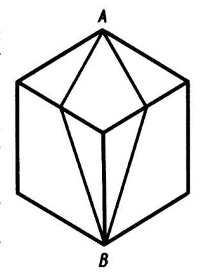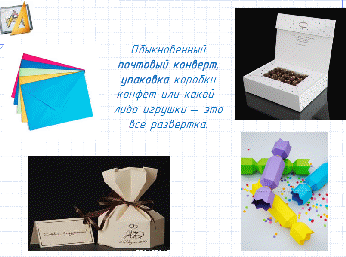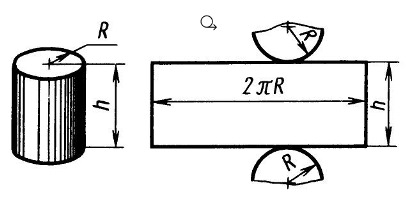Instructions
Having examined a regular triangular prism, you will be convinced that its bases contain regular triangles, A side faces are rectangles. It is these figures that you have to draw.
Start by unraveling the side surface. Measure the edge that lies between the base and one of the sides, as well as the edge between the two sides. Since the prism is correct, these dimensions will be sufficient. Multiply the side of the triangle by 3. Draw a straight line. Place the resulting size on it.
Draw perpendiculars to the start and end marks. Set aside the length of the edge located between the side edges. Connect the marks with a straight line. You have a rectangle.
Divide the bottom and top sides into 3 equal parts. Connect the opposite points. The large rectangle was divided into 3 identical small ones, each of which represents an image on the plane of one of the side faces. Thus you have obtained a side scan of a regular triangular prism. All that remains is to complete the foundations. The method of drawing them depends on what you need the development for.
If you are just making a drawing, continue down the vertical sides of the first small rectangle. Along these lines from the base of the rectangle, mark equal distances and connect them. You now have one of the sides of the base. Construct the angles - in an equilateral triangle, each of them is 60°. Continue the rays until they intersect. The base development is ready. The second base, if needed, is built in a similar way.
A reamer may also be needed to make a prism from paper or tin. In this case, all edges must touch. Construct the development of the side surface in exactly the same way as in the first case. Build the bases directly on the sides of one of the small rectangles. The construction method is the same as for the drawing. Don't forget to leave allowances for gluing on one side of the side surface and on both free sides of one of the bases.
It is more convenient to start building a prism with irregular triangles at its base. Draw a triangle with the given parameters (the problem may give the dimensions of all sides, the dimensions of two sides and the angle between them, the dimensions of one side and two adjacent angles). You must also know the height of such a prism. Draw a horizontal line and plot on it the sum of all sides of the base. Draw perpendiculars to the resulting points and plot the height of the prism on them. Connect the resulting marks. On both horizontal lines set aside the dimensions of all sides of the base in sequence. Connect the dots in pairs.
DRAWINGS AND DEVELOPMENTS OF GEOMETRICAL BODIES. (8th grade)
GOALS:
- consolidate the conceptgeometric body;
Contribute self-study scans geometric bodies;
Develop spatial concepts and thinking, the ability to work with information sources;
Foster a sense of time and responsibility in the team.
TYPE OF LESSON: lesson on learning new material
MATERIAL SUPPORT: models of geometric bodies, textbooks, drawing supplies, scissors, drawing paper.
METHODS: conversation, drawings of geometric bodies and developments, modeling.
LITERATURE: “Drawing” Botvinnikov A.D., Vinogradov V.N., Vyshnepolsky I.S.
DURING THE CLASSES
1.Organizational part (1 min)
Very correct, very wise,
Let laziness not be a hindrance,
In the morning tell everyone: “Good... (morning)”
Well, during the day you should say: “Good... (day).”
2. Message about the topic and objectives of the lesson (1 min)
The topic of the lesson is “Developments of geometric bodies.” We must remember the basic geometric bodies, find out how their developments are constructed.
3. Repetition of previously studied (13 min)
1). Quiz “Remember geometric bodies” (3 min).
Three teams (in columns). The task is to remember geometric bodies. We will rely on your knowledge from the course in geometry, drawing, and technology. The team that gives the most correct answers will win.
2). Definition geometric shape details.
Task 1 (5 min). So, we already know that the shape of most objects is a combination of various geometric bodies or their parts.
Now let's check how well you remember the images of geometric bodies. The shape of each of them has its own characteristic features. By these characteristics we distinguish a ball from a cube, etc. You are already familiar with most of these bodies. We say "cube" and everyone imagines its shape. We say “ball” and again the image of a certain geometric body appears in our minds.
I'm giving you cards.
Assignment for option 1: write down the numbers of images of geometric bodies and their names in a notebook.
Assignment for option 2: write down in a notebook the numbers of images of geometric bodies of rotation and their names.
We exchanged notebooks and mutually checked the completed task.
Result
Polyhedral geometric bodies include:
1 - 6-gonal prism,
2, 11 - 6-gonal pyramid,
5, 14 - parallelepiped,
6 - cube,
10 - 6-gonal truncated pyramid,
12 - 4-gonal pyramid,
13 - 3-gonal pyramid,
15-3-angle prism,
16 - 5-gonal prism,
17 - 6-gonal prism,
18 - 6-gonal truncated prism (2 planes)
Geometric bodies of revolution include:
3, 9 - cylinder,
4, 7 - cone,
8, 19 - truncated cone,
20 - ball (or sphere),
21 - torus
Task 2 (3 min). Please look at the detail drawing
What is the name of this item?
Can you determine the shape of the part?
What geometric bodies are the part formed by the combination (or subtraction) of?
Task 3 (2 min) - together.
I name bodies, and you give examples of objects:Ball
Pyramid
Prism
Cone
Cylinder
Answer:
Planets, ball, globe
Pyramids at Giza
Pencil, brick
Firemen's bucket, cap, ice cream cone in the shape of a cone
Washer, can of canned food
4. Learning new material (10 min)
There are tables with study material on the desks. new topic
Take a pencil and draw on the faces of the cube (Fig. 1) the shortest path from the pointAnd to the pointIN.

Rice. 1. Cube
It would seem that you need to draw a line to the front vertex of the cube, and then down the edge. But this path, alas, is not the shortest.
Let's expand the faces of the cube into one plane, mark the pointsAAndB and connect them with straight lines, as shown in Figure 2.

Rice. 2.
The shortest path, as we see, passes through the middle of the edges of the cube, and not through its vertices. This path is indicated in Figure 3 by solid thin lines.

Rice. 3
The flat figure we obtained in Figure 2 is calledsweepCuba.
have great application in machine-building plants, shoe factories, and sewing workshops. To make machine casings, machine enclosures, ventilation devices, and pipelines, it is necessary to cut out their developments from sheet material.

Rice. 4
Sweepis a flat figure obtained by combining the surface of a geometric body with one plane.


![]()




When constructing a development, you must first know the true, naturaldimensions and shape of individual elements of an object in the drawing. In the simplest cases, developments can be drawn without using projections of the object. For example, to construct the development of a cube, it is enough to know the size of one edge of the cube.
Let's consider the construction of surface developments of some simple bodies. On the desks there are handout tables with examples of constructing developments of some geometric bodies.
Cube
To construct a cube development, it is enough to know the size of the cube edge. Let's say the cube edge size = 70 mm.
We take a ruler and a pencil in our hands. (Remind safety rules when working with drawing tools, scissors). I am on the board, you are on the cardboard.
Draw a square with sides of 70 mm in the middle of a sheet of cardboard. How many faces does a cube have? Correct - 6. We complete the development. Cut it out, glue it together.
Practical work. (15 minutes)
Now you have to perform developments of various geometric bodies. You are divided into 6 groups. By the end of the lesson you should have - quadrangular prism, triangular prism, quadrangular pyramid, triangular pyramid, cylinder, cone. On your tables are diagrams for performing developments of geometric bodies. Get to work.
Prism
Development of a straight surface represents flat figure, composed of side faces - rectangles and two equal base polygons.
To construct the development of a straight prism-parallelepiped, it is enough to know three dimensions: the length, width and height of the prism (Fig. 6).

Rice. 6. Development of the surface of a parallelepiped
Let's take the correct onestraight hexagonal prism(Fig. 7). All lateral faces of the prism are rectangles equal in widthAand heightN; prism bases – regular hexagons with a side equal toA.

Rice. 7. Development of a straight surface hexagonal prism
Because true dimensions faces are known to us, it is not difficult to construct a development. To do this, six segments are sequentially laid on a horizontal line equal to the side of the base of the hexagon, i.e. 6a. From the obtained points, perpendiculars are constructed, equal to height prismsN, and through endpoints perpendiculars draw a second horizontal line. The resulting rectangle (H x 6a) is a development of the lateral surface of the prism. Then the base figures are placed on one axis - two hexagons with sides equal toA. The outline is outlined with a solid main line, and the fold lines are outlined with a dash-dotted line with two dots.
In a similar way you can construct developments of straight prisms with any figure at the base.
Pyramid
Development of the surface is correct is a flat figure made up of lateral faces - isosceles or equilateral triangles And regular polygon grounds. For example, scans are shownregular quadrangular pyramid(Fig. 8) andregular pentagonal pyramid (Fig. 9).

Rice. 8. Development of the correct surface quadrangular pyramid
Solving the problem is complicated by the fact that the size of the side faces of the pyramid is unknown, since the edges of the faces are not parallel to any of the projection planes. Therefore, the construction begins by determining the true value of the inclined edgeS.A. Having determined by the method of rotation (see Fig. 8) the true length of the inclined ribSA equal tos"a" 1 , from arbitrary point Oh, how from the center they draw an arc with a radiuss"a" 1 . Four segments are laid on the arc, equal to side the base of the pyramid, which is projected in the drawing to its true size. The found points are connected by straight lines to the pointA. Having received a development of the lateral surface, a square is attached to the base of one of the triangles, equal to the base pyramids.

Rice. 9. Development of the surface of a regular pentagonal pyramid
Cone
Surface developmentdirect circular cone is a flat figure consisting of a circular sector and a circle (Fig. 10).

Rice. 10. Development of the surface of a right circular cone
Construction perform in the following way. Draw a center line and from a point taken on it, as from the center, with a radiusR 1 equal to the generatrix of the cones"a", outline an arc of a circle. IN in this example generator calculated using the Pythagorean theorem (a 2 +b 2 =c 2 ), equal to approximately 38 mm (L=√15 2 +35 2 =√1450≈ 38 mm). Then countsector angleaccording to the formula:

WhereR– radius of the circle of the base of the cone (15 mm);L– length of the generatrix of the side surface of the cone (38 mm).
In this exampleα = 360°⋅ 15/38 ≈ 142.2°.
This angle is constructed symmetrically with respect to center line with vertex at pointS. A circle with a center on the center line and a diameter of equal to the diameter base of the cone.
Cylinder
It is also well known that the scan is a rectangle, one side of which is equal to the height of the cylinder, and the other to the unfolded length of the base circumference 2πR (Fig. 11).

Rice. 11. Surface development straight cylinder
Ball
At school, during geography lessons, you use maps. On world maps (Fig. 12, a) Earth depicted as circles - the eastern and western hemispheres.
But is the sweep – a circle or, more precisely, two circles?
Let's try to expand and align the spherical surface with the plane. It will not be possible to do this without folds and tears. Many geometric figures easily unfold into a plane, but a ball does not.
If the surface of the globe is cut along the meridians into small slices (segments) and straightened, then in each of these straightened slices we may not notice any visible distortions. But we will get a scan with a gap (Fig. 12, b).

Rice. 12. Geographic map
It is these “slices” that are cut along the contour and glued one next to the other on the surface of the school globe. Take a closer look at the globe and you will see that this is so.
To get a map without a gap, you have to allow for some inaccuracies, which amount to distortion of directions, distances and areas that are not the same in different parts cards.
Developments of someregular polyhedra are presented in Figure 13: a) cube, b) tetrahedron, c) octahedron, d) icosahedron and e) dodecahedron.


Development of the surface of the pyramid.
In order to perform the development, let's determine what shapes the pyramid consists of.
Side surface pyramid consists of four equal triangles. To construct a triangle, you need to know the sizes of its sides. Equal edges the pyramids serve as the sides of the faces (triangles). From an arbitrary point we describe an arc with a radius equal to length lateral rib pyramids. On this arc we lay four segments equal to the side of the base. Extreme points connect with straight lines to the center of the described arc. Then we add a square equal to the base of the pyramid.

Fold lines should be drawn as a dot-dash line with two dots.
All clear? To consolidate new material, we will do it using cards practical work in pairs. And one at the board will perform the development of the cube.

5. Summing up (2 min)
What new did you learn in the lesson?
What did you meet?
Where are they used?
What have you learned?
6. Reflection (1 min)
Did you like the lesson?
Are you satisfied with your work in class?
Draw a smiley face in your notebook that corresponds to the assessment of your work in class.
Student assessment
Homework.
§16.
Complete the scan
(optional). Creative task: make a visual representation of a miracle animal using verbal description. "A new animal was brought to the zoo. This is what it looks like: a cone-shaped body, on top of which is a head in the shape of a regular triangular prism: on its edges there are two spherical eyes. He also has two cylindrical horns, his ears are semi-oval plates, and his legs are high parallelepipeds."
4.33 /5 (86.67%) 6 votes
Prism development. Prism surface development.
Lateral surface development correct prism, the base of which is regular n-gon(V in this case hexagon), height N shown in Fig. 1. The sweep length is n α and also has a height N . The base of the prism can be attached to the faces of any of the lateral planes of the development or made separately.

Figure 1. Development of a hexagonal prism.
Truncated prism development.
Development of a regular prism, the base of which is a pentagon, truncated by a plane at an angle α , shown in Fig. 2. The length of the side surface development is equal to the perimeter R base of the prism. The lengths of the vertical edges of the scan, for example 00°, 11°, are equal to the lengths of the corresponding edges of the prism 0'0 1 0, 1'1 1 0, etc. The construction of the upper base can be done by drawing perpendiculars to the segment 0 1 0 3 1 0 V corresponding points and after selecting an arbitrary vertex of the upper base, for example 0", describe an arc from the selected point as from a center with a radius of 0°1° to the intersection of the perpendicular at point 1".

Rice. 2. Pentagonal prism development truncated by a plane.
From center 1” with a radius of 1°2°, an arc is described until it intersects the perpendicular at point 2”. Construction continues until the polygon is closed. The resulting polygon 0″1″2″…5″ is attached to any scan edge or performed separately.
No similar articles
